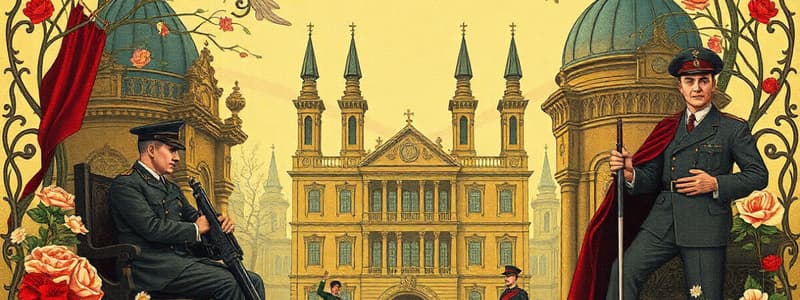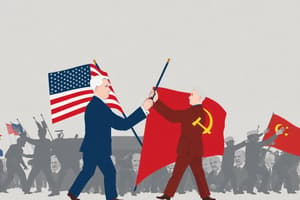Podcast
Questions and Answers
What was the primary ideology promoted by the USSR that directly conflicted with American values after World War II?
What was the primary ideology promoted by the USSR that directly conflicted with American values after World War II?
- Fascism, promoting a totalitarian government with extreme nationalism and militarism.
- Marxism-Leninism, aiming to subvert American ideals of democracy, human rights, and freedom. (correct)
- Isolationism, seeking to avoid international conflicts and focus on domestic issues.
- Democratic Socialism, advocating for social justice within a democratic framework.
Which of the following best describes the initial Soviet actions in Eastern Europe after World War II?
Which of the following best describes the initial Soviet actions in Eastern Europe after World War II?
- Eliminating the political and economic independence of countries like Poland and Czechoslovakia. (correct)
- Facilitating the establishment of democratic governments through free and fair elections.
- Providing financial aid and resources to rebuild infrastructure and promote self-determination.
- Integrating Eastern European economies into the Western European market to promote rapid recovery.
What was the main objective of the Marshall Plan, initiated by the United States after World War II?
What was the main objective of the Marshall Plan, initiated by the United States after World War II?
- To promote isolationist policies and limit international involvement.
- To establish military bases in strategic locations around the world.
- To provide military support to communist movements in Eastern Europe.
- To restore the war-ravaged economies of Western Europe and Japan. (correct)
What was the primary goal of the U.S. Containment Strategy during the Cold War?
What was the primary goal of the U.S. Containment Strategy during the Cold War?
Which of the following scenarios exemplifies the Soviet Union's efforts to expand its influence beyond Eastern Europe during the early Cold War period?
Which of the following scenarios exemplifies the Soviet Union's efforts to expand its influence beyond Eastern Europe during the early Cold War period?
In what way did the Communist takeover in China in 1949 impact the global balance of power during the early Cold War?
In what way did the Communist takeover in China in 1949 impact the global balance of power during the early Cold War?
How did the United States respond to the Soviet Union's diplomatic and military pressure on Turkey and Iran in the Middle East?
How did the United States respond to the Soviet Union's diplomatic and military pressure on Turkey and Iran in the Middle East?
What differentiated the conflicts in Indochina and Korea from the Soviet actions in Eastern Europe during the early Cold War?
What differentiated the conflicts in Indochina and Korea from the Soviet actions in Eastern Europe during the early Cold War?
Flashcards
Cold War
Cold War
Post-WWII global tension between the U.S. and USSR, involving ideological and geopolitical rivalry.
Joseph Stalin
Joseph Stalin
Dictator of the USSR who expanded Soviet influence post-WWII and promoted Marxism-Leninism.
Marxism-Leninism
Marxism-Leninism
The political and economic ideology promoted by the USSR.
Marshall Plan
Marshall Plan
Signup and view all the flashcards
Containment Strategy
Containment Strategy
Signup and view all the flashcards
Ho Chi Minh
Ho Chi Minh
Signup and view all the flashcards
Kim Il Sung
Kim Il Sung
Signup and view all the flashcards
Mao Tse-tung
Mao Tse-tung
Signup and view all the flashcards
Study Notes
- Following World War II, American Sailors confronted a new global threat to democracy, human rights, and freedom from the USSR.
- Joseph Stalin's USSR aimed to consolidate wartime conquests and advance Marxism-Leninism.
- This ideology contradicted the values held by most Americans.
- Stalin eliminated the independence of Eastern European nations like Poland and Czechoslovakia.
- Diplomatic and military pressure was applied to Turkey and Iran.
- War material was supplied to Greek Communists.
- In 1948, the Soviets caused a confrontation over control of Berlin.
- Communist movements in the Far East received military aid from Moscow.
- Ho Chi Minh led Vietnamese Communists against the French in Indochina.
- Kim Il Sung and Syngman Rhee fought for control of Korea.
- In 1949, Mao Tse-tung established the People's Republic of China.
- President Harry S. Truman responded to the Soviet threat with economic, political, and military measures.
- The Marshall Plan used billions of dollars to restore the economies of Western Europe and Japan.
- The U.S. government strengthened political ties with anti-Communist governments.
- The Truman administration adopted a "Containment Strategy" to defend against the Communist world.
- The United States Navy guarded the containment wall throughout the Cold War.
Studying That Suits You
Use AI to generate personalized quizzes and flashcards to suit your learning preferences.




